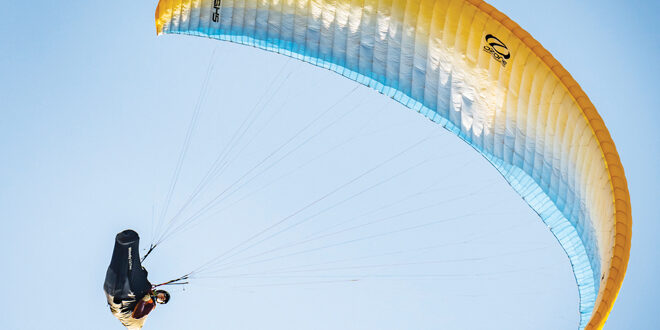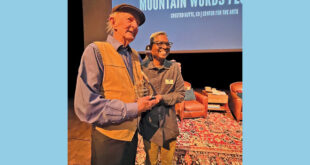Flying high above Crested Butte for decades
by Dawne Belloise
Childhood fantasies of flight begin from the time we run against the wind feeling the tug of the string and experience the sensation of lift as our first kite launches aloft into the day. Perhaps it’s the liberation from the shackles of gravity and escapism from current circumstances that inspires us to lucidly dream of flying. Here in Crested Butte, many of us are still pursuing our childhood pleasures with grown-up toys. Flying is no exception. Starting in the late 1970s, self proclaimed pilots began launching themselves from Crested Butte Mountain on hang gliders and in 1976, the Crested Butte Soaring Society (CBSS) was officially formed and has about a dozen members today with three hang glider pilots and the remainder paragliders. The sport was relatively new throughout the U.S. back when the CBSS launched and much more challenging in the ever-changing weather conditions of the mountains.
Hang gliders and paragliders now have to engage in strict certification through education. They must essentially become micro meteorologists. Since the ‘70s and ‘80s, their equipment has evolved for optimum and ultimate flight through better technology and design. Hang gliders are suspended from the airframe in a harness, flying like Superman, head forward with their bodies stretched prone behind them. They shift their body weight to control the wing’s direction and head off searching for thermals – updrafts of heated air that will carry them to higher altitudes, allowing them to fly for hours.
Paragliders fly suspended in a harness below their fabric wing, also known as a ram-air airfoil or parafoil, which is shaped by air pressure entering the tubular vents that form a row of cells in the front. Since the cells are only open in the front leading edge, the incoming air keeps the wing inflated, maintaining its shape. The difference between a parachute and a parafoil is their purpose – parachutes are designed for descending only while paragliders ascend.
Paraglider and hang glider pilots often observe birds to know where the thermals are. Pilots, like birds, center themselves in the core of the thermals, circling to maximize lift and gliding from one thermal to the next. Thermals are also identified by cumulus clouds, which mark the top of a rising column of warm, humid air as it reaches dew point and condenses to form a cloud. The CBSS flock of rare birds can be seen circling the thermals with Mt. CB as their backdrop.
Scott Yost is one of the hang gliding pilots and member of CBSS. He knows first-hand that the weather here is unique. “Flying in the Rockies is the most exciting and the most difficult for soaring flight. At midday in a CB summer, it’s possible to catch thermals and ride up 2,000 feet a minute. You just hang on! That’s really what you’re going for,” Scott says of the thrill. “It will mellow out as you get higher.” Always searching for thermals since they have no source of motorized power, hang gliders need to rise 200 feet per minute just to maintain flight because as Scott says, “You’re always sinking.” But gliders can soar up to 17,999 feet by Federal Aviation law. Scott’s personal high was 17,000 feet. He has launched from Villa Grove to land in Crestone, 40 miles away. His longest flight time was four hours. Scott compares the preference of hang gliding to paragliding as preferring snowboarding to skiing. “It’s more attractive to me to be in a prone position as opposed to a seated position.” But he also feels that hang gliding may be dying out in favor of the more convenient aspects of paragliding, “My pack up is 12 feet long. Paragliders can fit their equipment into a backpack that only weighs about 35 lbs.”
Up there where birds rule, the feathered flyers have a curiosity about the strange brethren hovering around their thermals. “They look at you, they come to you, they’re really curious about you,” Scott tells stories that most pilots share. “I’ve flown with bald eagles, ravens and castrols and they are the ultimate in thermaling. I’ve gotten in thermals with birds 5 or 10 feet below me and can see every feather and their talons,” he says, still awed. “I’ll be doing my best to climb in the thermal and the birds will core through me!” (“core” meaning to get into the center of the thermal).
Rusty Whitley has been flying locally for 47 years, since the summer of 1974 as a Western State College student. “But my first flight was when I was 15,” he says. “In the very beginning, they’d ski launch off the T-bar hill on the mountain, taking short, baby flights.” Rusty has soared to 20,800 feet, piloted his hang glider from Bedrock, Colorado, to Glenwood Springs, flying over the Uncompahgre Plateau and the Grand Mesa for 115 miles. He’s been outfitting hang gliders with equipment, both nationally and internationally, from his Gunnison home for 30 years now through his store, Gunnison Gliders. “I’m universally known and you just call me up if you want something,” he says modestly of his international reputation that doesn’t even require a website.
Ben Eaton, current president of the CBSS, pilots a paraglider and says he spent his first four years hiking the mountain and launching off. He’s also flown from Anthracite Mesa above Pittsburg, the caves up Cement Creek and Willow Creek in Gunnison which is a soaring site overlooking Blue Mesa Reservoir. “We’ve gone from being in the dark to being very visible on an open ski area. The CB Soaring Society has been around for 45 years; there’s a long line of great pilots who have flown from the Butte,” he says appreciatively of CBMR allowing them to launch from the mountain.
Ben started flying in 2004, in Geneva, Switzerland. “You’d launch in France and land in Switzerland.” Ben notes that there are flight schools in Boulder and Grand Junction, “But the place you should go to learn is in Draper, Utah, at a site called The Point of the Mountain.”
Ben’s had his own rapturous experiences from the air over the years. “There were a couple of falcons that lived on CB peak and they’d come out and play with us. The two would play with one another and if we’re soaring above the peak, they’d start toying with us, definitely curious,” Ben laughs. “They’d come close enough to touch their wingtips to ours,” he says of the sort of handshake, “more of an acknowledgement of your presence. They want to check you out. It’s pretty obvious who’s dominant in the sky… they are.”
In another moving experience from the air Ben recalls, “The coolest thing I’ve had happen was when I was flying with my wingman (they always fly with a buddy for safety) Bo Thomson. We were flying from Anthracite Mesa and we were having a really good thermic flight when the forest underneath us started moving.” He paints an image of a dark mass separating from the trees, “There were about 300 head of elk that you could only see from directly above. We followed them for about 5 miles towards Cloud City. They saw our shadows and that had spooked them,” he says, still enchanted with the memory.
The technology of paragliding has gotten much better, Ben explains, “Our glide ratio is better. We’re 8 to 1, which means 8 feet over and 1 foot down, in zero lift. They do research to make these wings safer and have better performance.” It was those early days of hang gliding that defined it as a dangerous, daredevil sport when equipment design was in its experimental phase and training wasn’t as extensive. The accident rate has been dramatically decreased by both training and well-designed modern wings with the emphasis on safety – pilots know the weather and when to come down or not go up at all.
Tony Brown is one of the originals flying hang gliders since 1979 and first flew Crested Butte in ‘81. “We get really close to birds during migration. That’s a great force of nature that we’re tapping into that the world can’t see… feeling the pulsing of the atmosphere and pushing us upward,” Tony says. He then describes a golden day, warmly crisp and sunny, “In the fall, sometimes the aspen leaves get pulled up into thermals,” like a great sunlit spiral, thousands of dancing gold specks being sucked upwards into the bright blue heaven.
On the warmest days of summer, pilots will be dressed as though they’re going skiing because it’s much colder up at altitude. “Our Camelbacks usually freeze but when you get way up there at cloud base, you can skim the clouds,” Tony says. His personal high was 24,000 feet at a Telluride Airmen’s Rendezvous where they had special FAA permission to exceed the top altitude limit. “I’m always looking to take long flights. I think our potential has barely been tapped here,” Tony feels.
Flying cross-country was first done from Crested Butte by Tommy Boylon aka Captain Rainbow. In the late ‘80s he was the first to fly across the Continental Divide, landing a little below Monarch Ski Area… almost not making it. Tony describes his experiences. “Sometimes I fly out and zone out and watch the birds (for thermal indicators). It feels like an instant entry into another reality, a type of wildness… everything changes. Even if it’s easy flying, it’s the kind of thing that always takes a lot of focus and keeps your mind off mundane things. Sometimes you can float around like you’re in a boat on a pond… but you always keep a little scan going. Other times it’s completely taxing to use all your faculties to keep in a thermal and stay out of your friends’ way. Sometimes you just kind of get smacked around in the sky. Sometimes you can just drive your glider around the sky. The challenges are always unique and ever changing.”
Scott Yost summarizes what most of us can only imagine, “It’s the boyhood dream of flying and most people will agree that hang gliding or paragliding is the purest form of flight. There’s nothing closer to being a bird.”
 The Crested Butte News Serving the Gunnison Valley since 1999
The Crested Butte News Serving the Gunnison Valley since 1999





